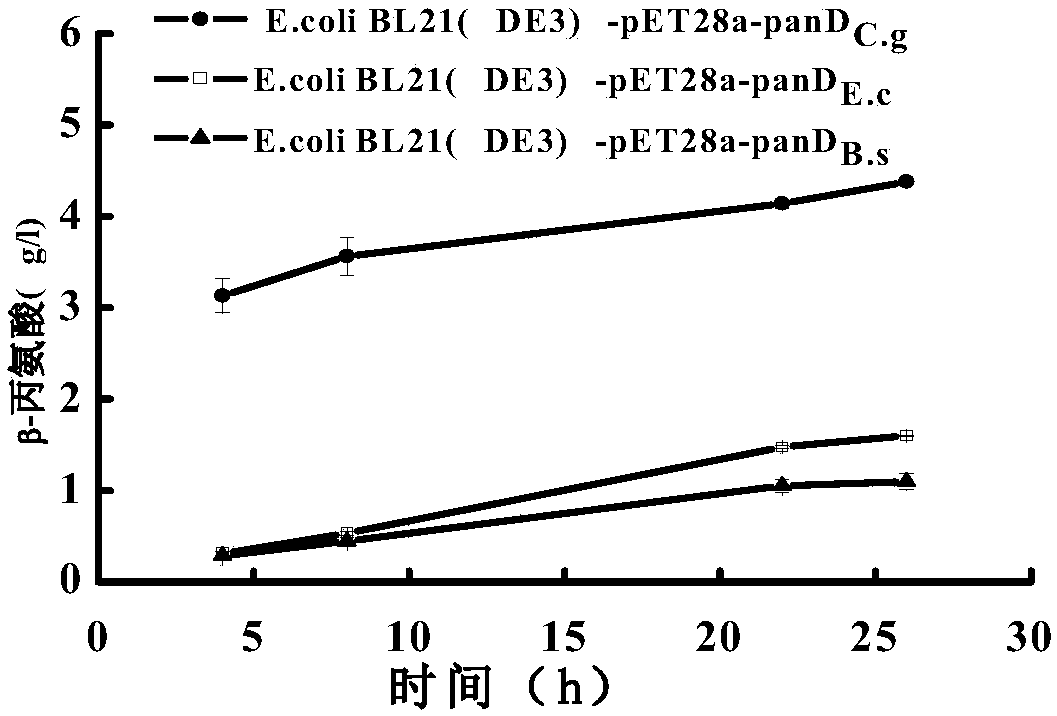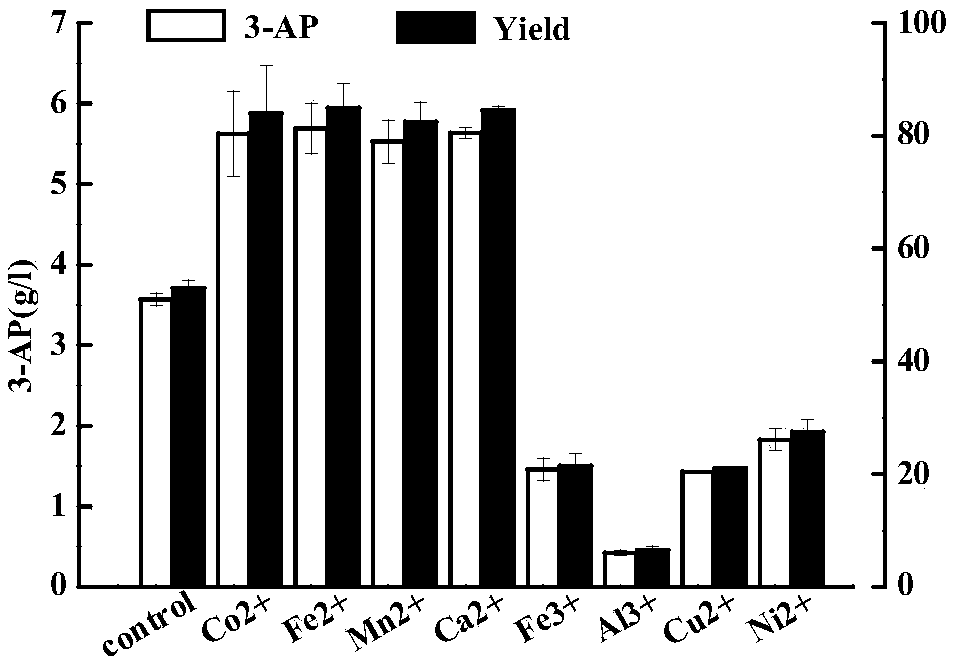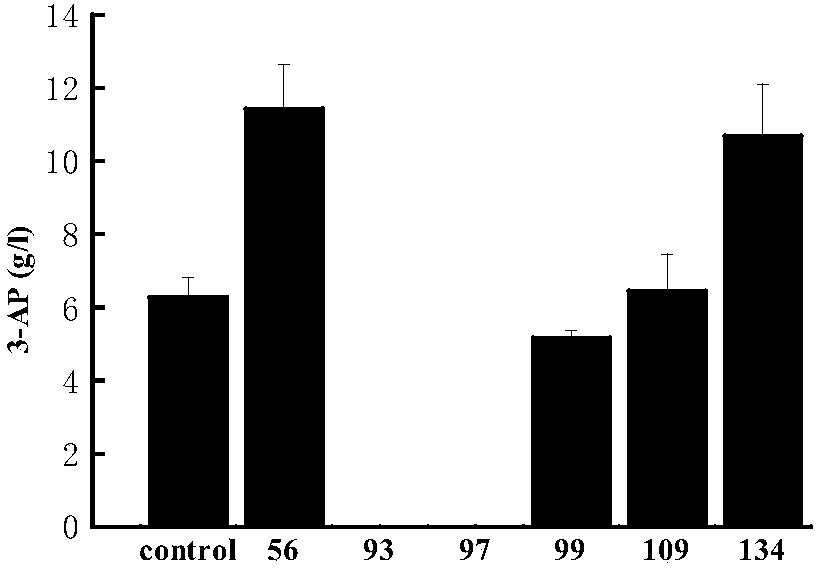panD mutant gene, genetically engineered bacterium and application of genetically engineered bacterium in catalytic production of beta-alanine
A technique for mutating genes and genetically engineered bacteria, applied in genetic engineering and its application in the catalytic production of β-alanine, in the field of panD mutant genes, can solve the problems of restricting the application of PanD, insufficient recombinant expression and activity, and achieve The effect of clear breeding goals and high efficiency
- Summary
- Abstract
- Description
- Claims
- Application Information
AI Technical Summary
Problems solved by technology
Method used
Image
Examples
Embodiment 1
[0033] Example 1: This example compares the effects of panD genes from different sources on the production of β-alanine.
[0034] Construction of strains from three different gene sources:
[0035] Extract the genomic DNA of Escherichia coli Mg1655, C.glutamicum (ATCC13032), and Bacillus subtilis (in the laboratory) and use it as a template to amplify the L-aspartic acid-α-decarboxylase gene panD by PCR, and the PCR product is passed through After agarose gel electrophoresis identification, recovery, and purification, the fragment panD with NcoI and XhoI restriction sites was obtained, and the fragment was connected with the recombinant plasmid pET-28a treated with the same restriction endonuclease, using T4DNA ligase Connect at 25°C for 30min.
[0036] The above ligation solution was transferred to Escherichia coli Transl-T1 competent cells (Quanshijin Biotechnology Co., Ltd.), spread on LB plates with 50 mg / L kana resistance, and cultured overnight at 37°C.
[0037] Pick a s...
Embodiment 2
[0039] Example 2: Effect of metal ions on catalytic reactions.
[0040] Pick the recombinant strain E.coliBL21(DE3)-pET28a-panD C.g A single colony of 50mg / L kanamycin-resistant 5ML LB shake tube, cultured for 6-8h, transferred to 100ml LB containing 50mg / L kanamycin-resistant, to OD 600 =0.6, add 0.5mmol of IPTG, culture in a shaker at 30°C, and after 10h, centrifuge at 6000g for 5min. Add L-aspartic acid to the recombinant strain: 10g / L (adjust the pH to 7.0 with sodium hydroxide), add buffer Mops (pH6.0), 50mM Fe 2+ , 37°C, 200rpm, sampling after 12h, liquid phase detection of accumulation of L-aspartic acid and β-alanine, such as figure 2 shown.
Embodiment 3
[0041] Example 3: Construction of panD gene mutant library.
[0042] (1) Escherichia coli BL21(DE3) / pET28a(+)-panD obtained in Example 1 C.g Inoculate in LB liquid medium, culture in a shaker at 30°C, centrifuge at 6000g for 5min after 10h, collect bacterial cells, and extract plasmid pET28a with a plasmid extraction kit (purchased from Shanghai Sangon Bioengineering Technology Service Co., Ltd.) (+)-panD; LB liquid medium consists of: peptone 10g / L, yeast powder 5g / L, sodium chloride 5g / L, kanamycin 50mg / L.
[0043] (2) The establishment of error-prone PCR reaction: (a) design the forward primer (C.g-panD-NcoI-F, catg CCATGG GCATGCTGCGCACCATCCTC, the underline is NcoI restriction site) and reverse primer (C.g-panD-XhoI-R: ccg CTCGAG CTAAATGCTTCTCGACGTCAAAAAGCC, the underline is the XhoI restriction site); (b) Prepare 50 μL of PCR reaction mixture, the system is: 10×Taq buffer: 5ul, Mn 2+ (50mmol / L): 3.5ul, Mg 2+ (25mmol / L): 14ul, DNA template: 10ul, 10×dNTP: 5ul, upstre...
PUM
 Login to View More
Login to View More Abstract
Description
Claims
Application Information
 Login to View More
Login to View More - R&D
- Intellectual Property
- Life Sciences
- Materials
- Tech Scout
- Unparalleled Data Quality
- Higher Quality Content
- 60% Fewer Hallucinations
Browse by: Latest US Patents, China's latest patents, Technical Efficacy Thesaurus, Application Domain, Technology Topic, Popular Technical Reports.
© 2025 PatSnap. All rights reserved.Legal|Privacy policy|Modern Slavery Act Transparency Statement|Sitemap|About US| Contact US: help@patsnap.com



